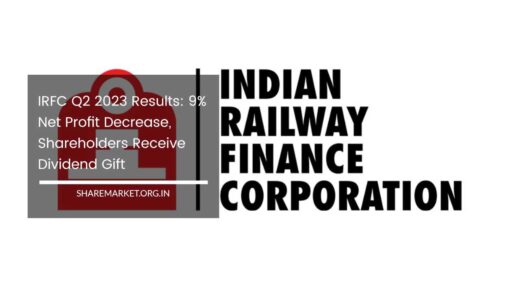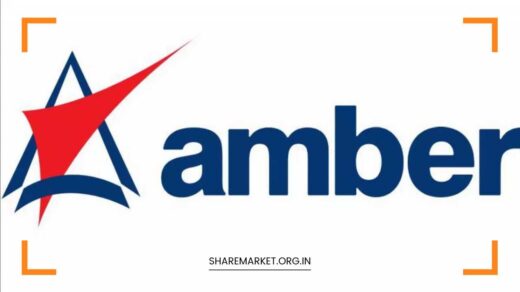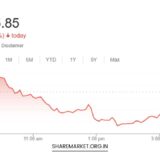BSE Created History, Market Cap of Listed Companies Crossed ₹300 Lakh Crore for the First Time

BSE Created History
The Bombay Stock Exchange (BSE) witnessed a significant milestone on July 5 as the total market capitalization of listed companies surpassed Rs 300 lakh crore for the first time.
This record-breaking achievement reflects the overall growth and value of the stock market. As a result, stock market investors experienced an increase in their wealth, amounting to approximately Rs 49,000 crore on that particular day.
Although the BSE’s benchmark index, the Sensex, concluded a five-day positive streak by closing with a slight decline of 33 points, the broader market displayed continued growth.
This upward trend contributed to the overall increase in market capitalization. Notably, the sectors that experienced the maximum gains were FMCG (Fast-Moving Consumer Goods), automobile, and oil and gas stocks. Investors in these sectors reaped the benefits of favorable market conditions.
Conversely, banking and financial stocks experienced a downward trend, witnessing a decline in their market performance.
This fluctuation in different sectors is a common occurrence in the stock market, where individual sectors respond to various market dynamics and external factors.
The achievement of crossing the Rs 300 lakh crore market capitalization milestone reflects the positive sentiment and investor confidence in the Indian stock market.
It showcases the potential for growth and wealth generation available to investors, highlighting the significance of the stock market as a valuable asset class.
Market participants closely monitor these developments, keeping a keen eye on sector-specific trends and overall market movements to make informed investment decisions.
The trading session concluded with the 30-share index Sensex of the Bombay Stock Exchange (BSE) recording a decline of 33.01 points or 0.05 percent, closing at a level of 65,446.04.
Similarly, the 50-share index of the National Stock Exchange (NSE), Nifty, ended the day at 19,398.50, registering a modest gain of 9.50 points or 0.05 percent.
Investors Earned Rs 49,000 Crore
On July 5, the total market capitalization of companies listed on the Bombay Stock Exchange (BSE) reached a significant milestone, surging to Rs 300.06 lakh crore compared to the previous trading day’s figure of Rs 298.57 lakh crore.
This increase of approximately Rs 1.49 lakh crore signifies a remarkable growth in the market capitalization of BSE-listed companies.
As a result, investors witnessed a significant boost in their wealth, amounting to around Rs 49,000 crore. This substantial increase in investors’ wealth highlights the positive impact of the rise in market capitalization.
It indicates the collective value and growth experienced by companies listed on the BSE, translating into increased wealth for investors who hold shares in those companies.
The rise in market capitalization signifies the overall confidence and optimism in the market, as investors continue to invest and benefit from the performance of listed companies.
This surge in wealth further emphasizes the potential for generating significant returns and wealth creation through investments in the stock market.
Investors closely monitor market capitalization figures, as they provide insights into the overall health and growth of the stock market.
The increase in market capitalization demonstrates the positive sentiment and economic growth within the market, attracting more investors and contributing to the overall development of the financial ecosystem.
These 5 Stocks of Sensex Gained the Most
Out of the 30 stocks comprising the Sensex, 20 of them closed with gains on the specified trading day. Among these, Maruti Suzuki’s shares emerged as the top gainer, experiencing a substantial increase of 3.52 percent in their value.
This surge in share price reflects positive investor sentiment and market demand for Maruti Suzuki’s stock.
Following Maruti Suzuki, other notable gainers in the Sensex included Tech Mahindra, IndusInd Bank, ITC, and Hindustan Unilever (HUL).
Tech Mahindra’s shares exhibited strong performance, closing with a gain of 1.97 percent. The positive market sentiment towards the company can be attributed to various factors such as positive news, financial performance, or market expectations.
IndusInd Bank’s shares also saw a notable increase, closing with a gain of 2.36 percent. This rise can be attributed to several factors, including positive market sentiment towards the banking sector, favorable financial results, or other company-specific developments.
ITC, a well-known conglomerate, witnessed a gain of 2.17 percent in its share price. This increase could be influenced by positive developments within the company, such as new product launches, expansion plans, or favorable industry trends.
Hindustan Unilever (HUL), a leading FMCG (Fast-Moving Consumer Goods) company, closed with a gain of 1.97 percent.
This rise in share price may be attributed to various factors, including strong financial performance, successful product launches, or positive market sentiment towards the FMCG sector.
These gains in the stock prices of Maruti Suzuki, Tech Mahindra, IndusInd Bank, ITC, and Hindustan Unilever highlight the positive market conditions and investor confidence in these particular companies.
Such performance attracts the attention of investors and market participants who closely track these stocks for potential investment opportunities or to assess market trends.
These 5 Stocks of Sensex Declined the Most
Among the 30 stocks comprising the Sensex, 10 of them closed with a decline on the specified trading day. HDFC Bank’s shares experienced the highest decline, with a notable decrease of 2.97 percent in their value.
This decline in share price can be attributed to various factors, such as profit-taking, market sentiment towards the banking sector, or specific news impacting the bank.
HDFC, another prominent financial institution, also witnessed a decline in its share price, closing with a decrease of around 0.40 percent.
Factors influencing this decline could include overall market conditions, sector-specific trends, or company-specific news or developments.
Bajaj Finserv, a diversified financial services company, saw its shares close in the red with a decline of approximately 1.15 percent. Market dynamics, industry-specific factors, or company-specific news could have contributed to this decline.
Wipro, a leading IT services company, experienced a decline in its share price of about 0.59 percent. This decrease could be influenced by various factors, including profit-taking, market sentiment towards the IT sector, or company-specific developments.
Axis Bank, a prominent private sector bank, witnessed a decline in its share price of approximately 2.76 percent.
Factors such as profit-booking, market conditions, or specific news impacting the banking sector may have contributed to this decline.
The declines in the share prices of HDFC Bank, HDFC, Bajaj Finserv, Wipro, and Axis Bank indicate the challenging market conditions faced by these particular stocks on the specified trading day.
1,981 Stocks Gained
During the trading session on the Bombay Stock Exchange (BSE), a total of 3,626 stocks were traded. Out of these, 1,981 stocks closed with gains, indicating positive market sentiment for these companies. These gains reflect the performance and investor demand for these particular stocks.
On the other hand, 1,518 stocks closed with losses, indicating a decline in their share prices. The decline in these stocks could be attributed to various factors, including profit-booking, market conditions, sector-specific trends, or company-specific news or developments that affected investor sentiment negatively.
A total of 127 stocks closed flat, meaning their share prices remained unchanged throughout the trading session. These stocks did not experience any significant movements in either direction and remained steady.
During the trading session, 179 stocks hit their upper circuit limits, which means their prices reached the maximum permissible increase allowed for the day.
This indicates strong investor demand and positive market sentiment for these stocks, potentially due to positive news, favorable financial results, or market expectations.
Conversely, 141 stocks closed by touching their lower circuit limits, implying that their prices reached the maximum permissible decrease allowed for the day.
This suggests negative market sentiment for these stocks, potentially influenced by factors such as negative news, poor financial performance, or sector-specific challenges.
These numbers highlight the dynamic nature of the stock market, where various factors contribute to the movement of individual stocks.
Investors closely monitor these statistics to assess market trends, identify potential investment opportunities, and gauge the overall sentiment of the market.
Disclaimer: The information provided here is solely for informational purposes and should not be considered as investment advice. Investing in the market involves inherent risks, and it is crucial to exercise caution and seek expert advice before making any investment decisions. We do not endorse or recommend any specific investments, and we urge investors to conduct thorough research and consult with financial professionals before committing any funds.

















